Germany and France are the most populous countries in the EU and also the bloc’s largest energy consumers. The neighbours therefore wield enormous influence over EU energy policy and are pivotal to implementing a sustainable transformation of the European energy system. This factsheet provides an overview of both’ countries’ national energy systems and their approaches to meet joint European policy landmarks.
Contents
- Geography, Politics, Economy: Different Landscapes Along the Rhine River
- How Energy Systems Compare: Primary Energy & Electricity Production
- Energy Consumption Declines in Both Countries
- Renewables set to grow fast across Europe
- Heating
- Electric mobility
- Energy storage
- Power grid
- Nuclear power: Phase-Out for Germany, Renaissance for France
- Fossil fuels: Germany Leads Consumption with Gas as Key Driver
Germany and France are the two largest economies in the European Union and both play a key role in the bloc’s goal to become greenhouse gas neutral by 2050. France also aims to achieve net zero emissions in that year, while Germany plans to reach the target five years earlier, in 2045. Whether or not these ambitious goals can be met will for the most part rely on their governments’ policy decisions in various sectors, especially the most energy-intensive, and subsequently on their swift implementation. But with roughly 25 years left to radically change their energy systems, meeting those targets also depends on the current reality in energy policy prevailing in each country.
Highlighting the two countries’ structural similarities and discrepancies allows a better understanding of where both of them stand as of 2023 and where they are headed given current trends. A caveat is that an entirely accurate comparison of available datasets is not always feasible between the two countries. This is due to the intrinsic complexities of counting emissions, investments and other developments in climate and energy policy, as well as the countries using different definitions, framings and accounting procedures to quantify their efforts. However, comparing available data can still offer an overview of the state of affairs in each country, where this can lead to contradictions, but also where synergies exist in the two approaches.
Geography, Politics, Economy: Different Landscapes Along the Rhine River
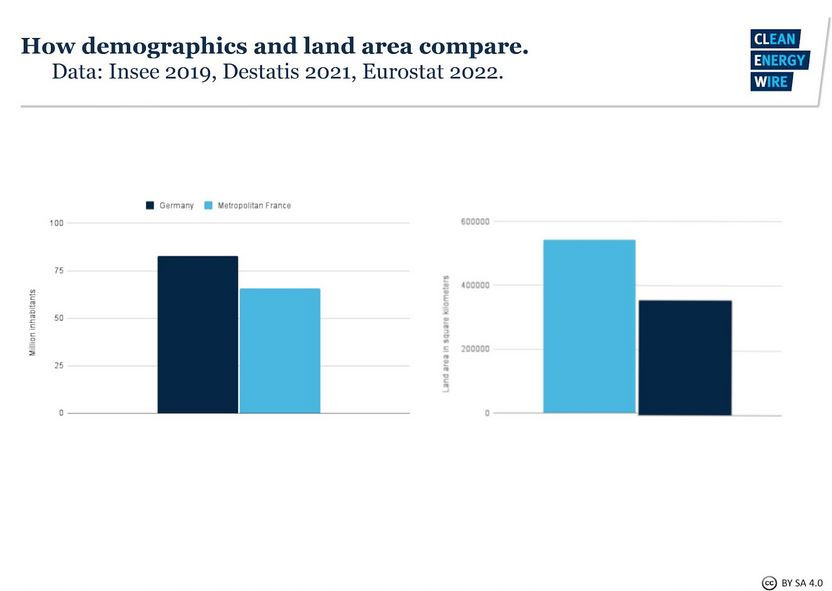
Situated on either side of western Europe’s central waterway the Rhine River, France and Germany constitute the European Union’s core region – not only geographically and historically, but also in terms of population, economic size and diplomatic weight. The two EU founding members share a wide range of cultural, institutional and political characteristics, and superficially may look quite alike on many accounts. However, they often are further apart on policy issues than their similarities suggest, in particular regarding organisational practices and ideological approaches.
France is the EU’s largest state by area. Its European territory (metropolitan France) covers some 544.000 km2. By contrast, Germany’s area is roughly 358.000 km2, only about two thirds the size of its neighbour. In terms of population, the picture is reversed: with about 83 million people registered in the country, Germany is the EU’s most populous member state. France comes second, with nearly 66 million inhabitants. Consequently, Germany has almost twice its population density.
France is a highly centralised state with the capital Paris as its unrivaled economic, cultural and political centre. Consequently, the French president is endowed with a high degree of direct decisional power that is compounded by the fact that coalition governments are uncommon in France. Germany, on the other hand, has a strong federal political structure for its 16 states. Several cultural and economic centres are scattered across the country and state governments enjoy relative autonomy vis-à-vis with the federal government Berlin. Moreover, coalition governments have been the norm for decades, meaning the German chancellor regularly has to rely on negotiating compromises before taking a decision.
Germany boasts the EU’s largest gross domestic product (GDP) ahead of France by a considerable margin – it is estimated at some 4.3 trillion dollars against 2.9 trillion dollars for its western neighbour (IMF, 2023). For income per capita, Germany leads France with about 51,000 to 44,000 dollars per year. Together, the two countries account for about one third of the EU population and for more than 42 percent of the bloc’s total GDP.
Regarding economic composition, the share of industry is much higher in Germany than it is in France: 23.5 percent (2021) and 13 percent (2022), respectively. This difference in part results from how both the countries navigated the fallout of the 2008 financial crisis, as well as the ensuing sovereign debt and Euro crisis, culminating in 2012. While French industrial production took a deep hit and remained significantly lower throughout the following decade, Germany’s economy emerged strengthened from the crisis not least thanks to its strong export-driven industrial sector.
France had some 259,300 companies in the industry sector in 2020, with 1,1 trillion euros of total revenue. The sector employed more than 3 million people in 2021. In Germany, the around 217,100 industrial companies registered as of 2021 generated a turnover of about 2.1 trillion euros and employed roughly 7 million people.
How Energy Systems Compare

Together, the two countries accounted for roughly 38 percent of total EU energy consumption in 2021. Of the roughly 1,300 million tons of oil equivalent used in the EU in 2021, Germany consumed 267 million tons and France some 224 million tons.
Apart from a heavy reliance on oil, the countries boast two rather different usage patterns with other energy carriers, especially regarding nuclear and coal power. Germany was the biggest coal producer in Europe in 2022 and accounted for 45 percent of its brown coal (lignite) and 25 percent of hard coal use. France, on the other hand, is by far the largest nuclear power producer in the bloc and accounted for 52 percent of total production in 2021.
Conversely, Germany opted to phase out nuclear power already in the year 2000 and completed its ‘nuclear exit‘ in April 2023, after a short delay caused by the energy crisis. In France, coal-fired power generation also has been reduced greatly in the past decades and as of 2023, only four plants were in operation in the country.
Primary Energy Production
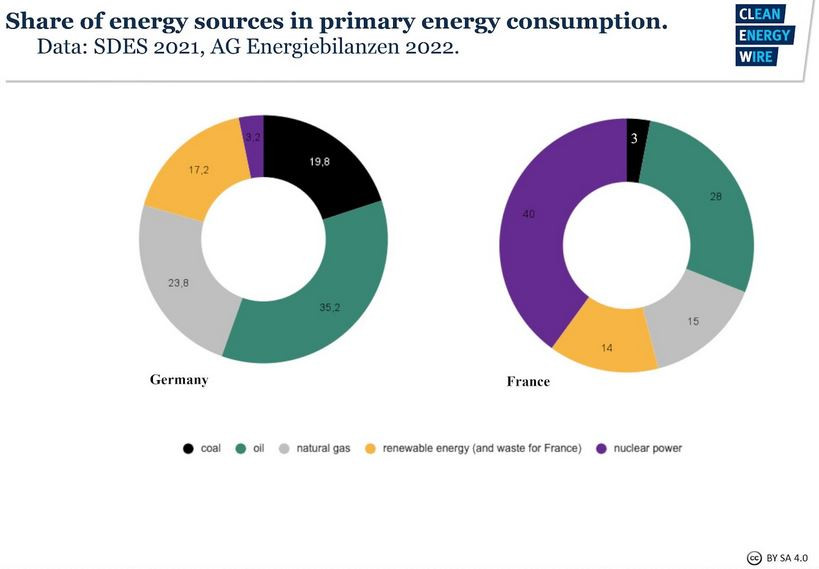
In Germany, renewable energy accounted for some 17 percent of primary energy consumption in 2022. Total renewable energy use was 489 TWh, of which a little over half came in the form of electricity, some 40 percent in renewable heating and 7 percent in the transport sector, the Federal Environment Agency (UBA) said. The three last operating nuclear plants provided roughly 3 percent to the mix while the remaining 80 percent were mostly composed of fossil fuels, clearly led by oil (35%), followed by natural gas (24%), and coal (20%).
In France, the primary energy mix was composed mainly of nuclear power (40%) Primary production of renewable energies in 2022 in France amounted to 345 TWh, the ministry said, including biomass (38%), hydropower (17%), heat pumps (12%), wind power (11%) and biofuels (6%). Fossil fuels accounted for 46 percent of primary production, mainly with oil (28%) as well, followed by gas (15%) and a marginal share of coal (3%).
Electricity Production
Both countries covered roughly a quarter of their final 2021 energy consumption with electricity, which is supposed to replace the bulk of fossil fuel use: About 23 percent in Germany and 25 percent in France.
Regarding electricity generation, nuclear power dominated in France with a share of 63 percent, the highest share of any country in the world. Nuclear was followed by renewable power installations, with a combined share of about 26 percent. Hydro power accounted for the bulk of that share (11%) – followed by onshore wind power (8.5%), solar PV (4%), and biomass and waste (2.4%). Gas (10%) was far ahead of oil and coal (<1% each) in electricity production. Offshore wind still lurked at a share of 0.1 percent.
In Germany, renewables accounted for 44 percent of electricity production in 2022, dominated by onshore wind power (17.5%), followed by solar PV (10.5%), biomass (7.5%), offshore wind (4.5%) and hydro power (3%). The remainder was overwhelmingly composed of fossil fuels: Coal (hard coal & lignite) still accounted for over 31 percent and gas for nearly 14 percent, followed by nuclear (6%) and oil (<1%).
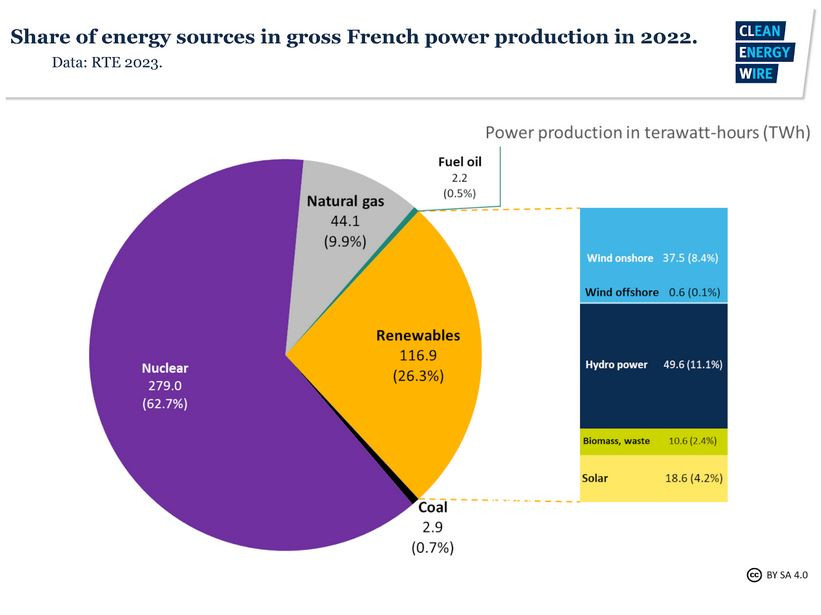
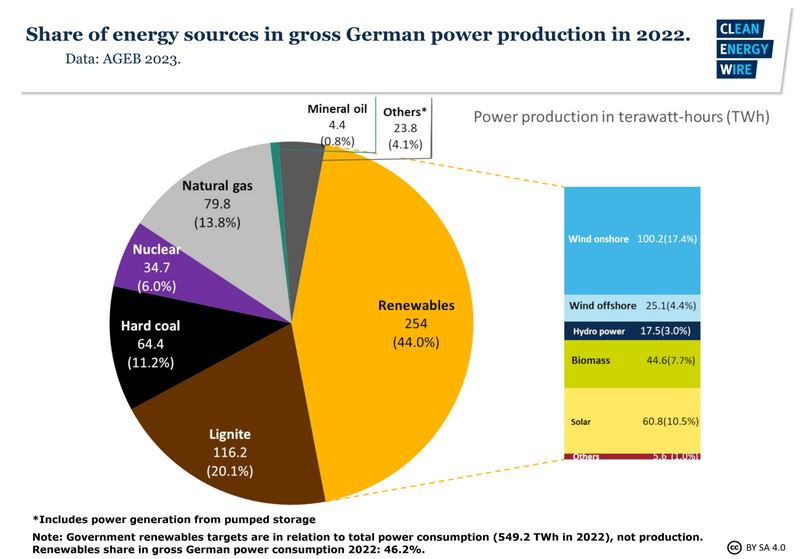
Energy Consumption Declines in Both Countries
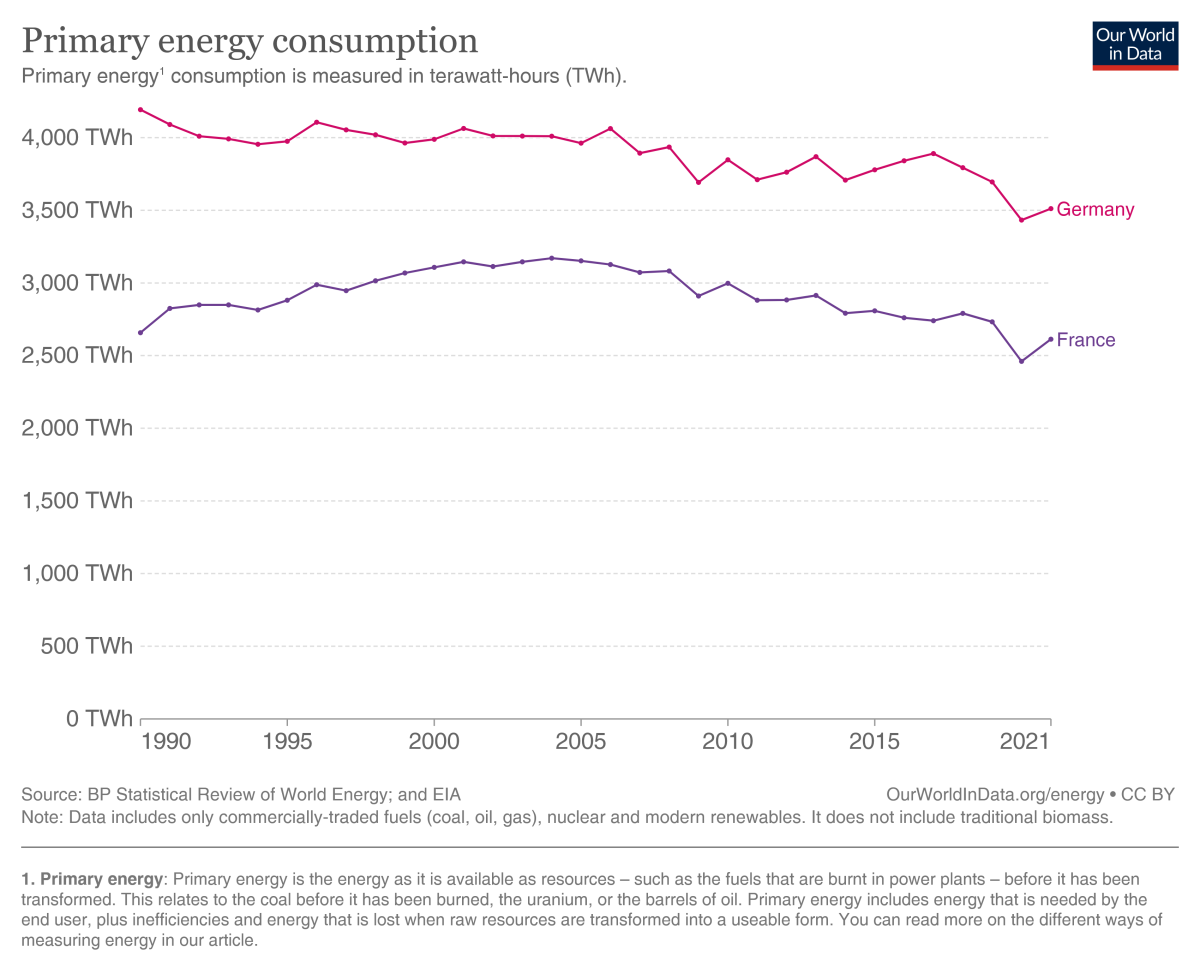
Consumption has generally been declining in both France and Germany since 1990, at a somewhat faster pace than in the then re-unified Germany, where many industrial sites in the formerly communist eastern states were shuttered in the decade following reunification – while its strong recovery in the wake of the 2008 financial crisis delayed further cuts.
The German government has set itself the goal of reducing primary energy consumption by 30 percent by 2030 and by 50 percent by 2050 compared to 2008 levels. (Govt’ Energy Efficiency Strategy 2050). In 2022, it had achieved slightly over 18 percent reduction, less than the 20 percent-target envisaged already for 2020.
The latest addition to the French government’s sufficiency plan was announced in mid-2023, by the Ministry of Energy Transition. It called for a long-term sufficiency approach among the largest companies and across sectors. Alongside efficiency efforts, the current national low-carbon strategy calls for a 40 percent reduction in energy consumption by 2050.
While total energy demand is set to fall in each country, the demand for electricity will increase as industrial processes, heat generation and transport become more and more electrified. By 2030, Germany estimates a demand of 600 terawatt hours (TWh) of electricity from renewable energies – based on higher gross electricity consumption of about 750 TWh.
French grid operator RTE estimates a demand of about 645 TWh of decarbonised electricity demand in 2050, pointing out it already stood at some 500 TWh in 2021.
Renewables Set to Grow Fast Across Europe
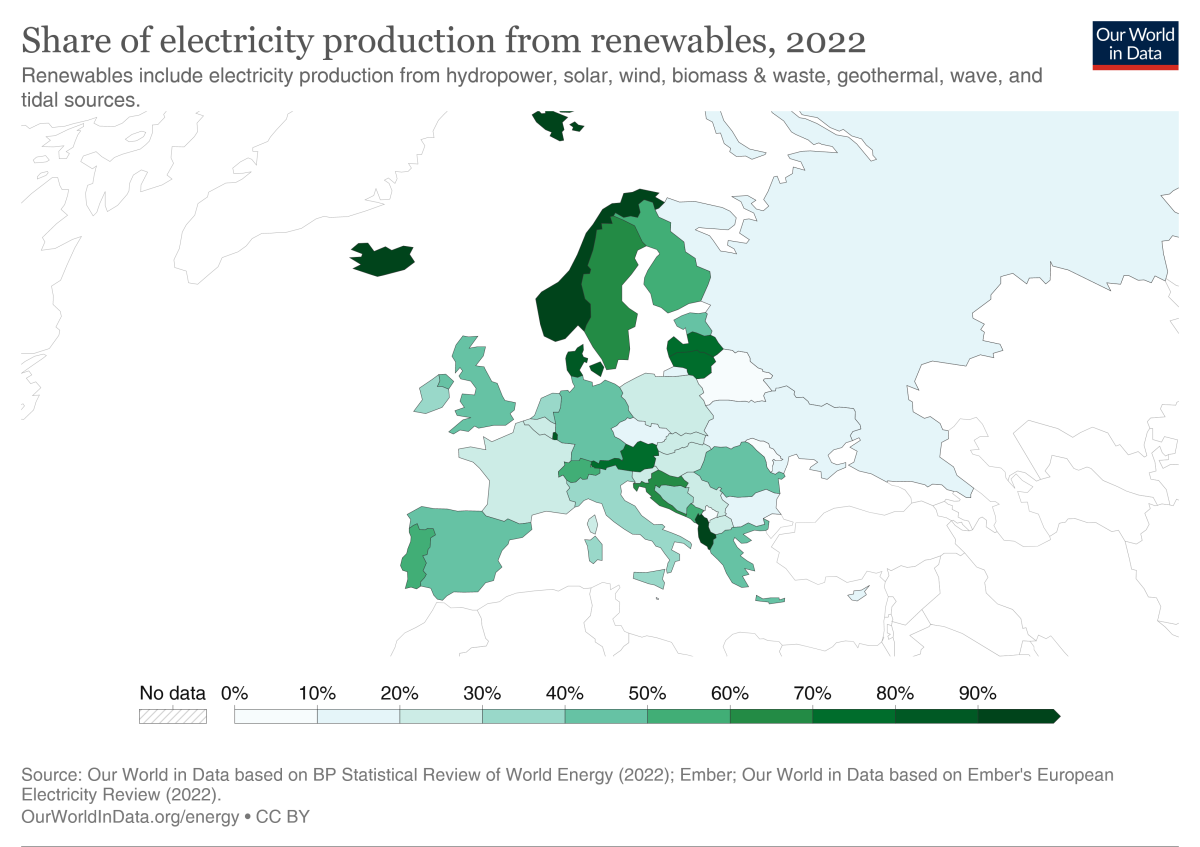
On a European scale, EU states agreed to increase the share of renewables in the overall energy mix to 42.5 percent by 2030, leaving an option open to possibly reach 45 percent – which would almost double the 2023 share of renewable energy in the bloc.
In 2022, total renewable capacity in Germany stood at roughly 148 GW (139 GW in 2021). About 58 GW of onshore wind capacity was installed, roughly 8 GW of offshore turbines, about 67 GW of solar PV arrays, 5 GW renewable hydro power and nearly 10 GW bioenergy (IRENA 2023). Together they produced about 244 TWh of net electricity, some 7.4 percent more than in the previous year, according to research institute Fraunhofer ISE.
In order to achieve the national goal of 30 percent renewable energy in gross final energy consumption formulated in its energy concept (from 20.4% in 2022) – and of 80 percent in electricity production fixed in the latest reform of its Renewable Energy Act – the government in Berlin plans to implement an expansion of wind power to 115 GW by 2030. According to the government, this translates to a fast scale-up and ultimately the construction of four to five new onshore turbines per day. Offshore wind capacity is supposed to increase more than threefold to 30 GW by the end of the decade, while the projected 2030 capacity for solar PV is 215 GW.
Total installed renewable power capacity in France was 65 GW in 2022 (60 GW in 2021), composed of 25 GW hydro power, roughly 21 GW onshore wind, 17 GW solar PV, 0.5 GW offshore wind (with a further 8 GW already projected). In total, they contributed about 136 TWh to gross power consumption, also around 7 percent more than in the previous year, the French Energy Transition Ministry informed.
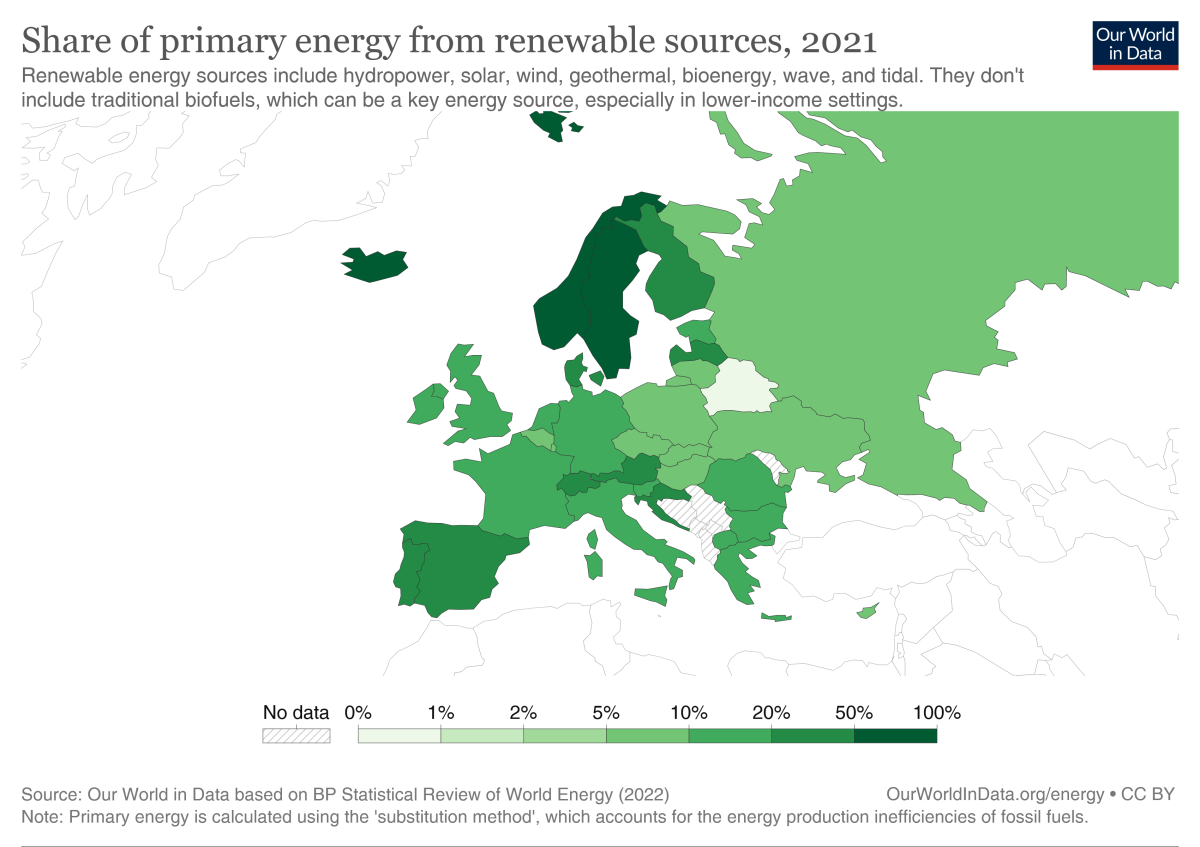
Paris wishes to develop its capacity gradually to reach a 33 percent share of renewable energy in gross final energy consumption until 2030 (it had reached 20.7% in gross final consumption in 2022), as fixed by the French Climate and Energy Law of November 2019. The long-term goal up to 2050 is to significantly increase installed renewable energy capacity, as set by French President Emmanuel Macron in his Belfort speech on energy policy in early 2022. He stated that solar PV production should be increased tenfold to over 100 gigawatts (GW), with 50 offshore wind farms to be deployed to reach a capacity of 40 GW, and that onshore wind power should be doubled to 40 GW.
While electricity generation with renewable power installations in France thus lagged behind that of its neighbours in 2021, the renewable energy share in energy consumption was closer to the European average.
Nuclear Power: Phase-Out for Germany, Renaissance for France
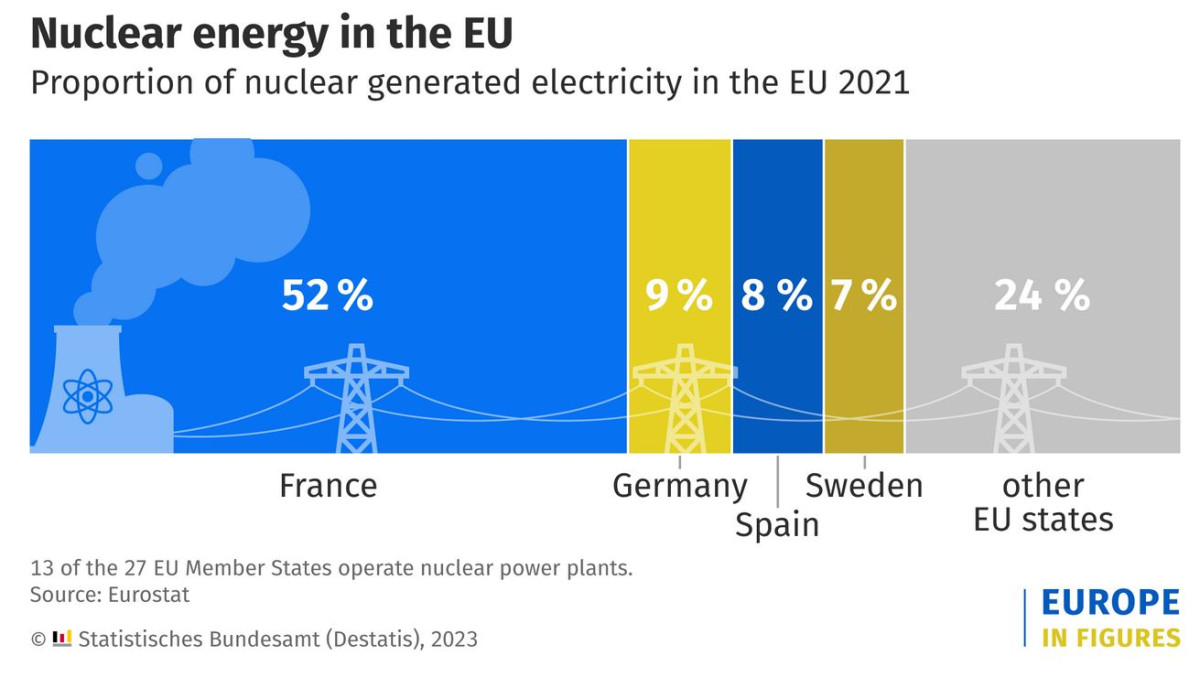
As far as nuclear power is concerned, Germany closed its last plant in April 2023, following a short delay caused by the energy crisis, while France plans to invest significantly in the sector. France and other European neighbours had appealed to Germany to further postpone the shutdown of its remaining three reactors to serve as a backup-capacity in the energy crisis. However, the German government ultimately completed the phase-out that had been prepared for more than 20 years, arguing the additional capacity provided by the reactors is of little use in stabilising the system. The shutdown did not impact power prices negatively in the immediate aftermath, as critics had warned. There is no agreement on building a nuclear waste repository for the radioactive legacy of Germany’s nuclear power era and the deadline for an ongoing search that was planned for 2031 was has been postponed in 2022.
In France, by contrast, 61 GW of nuclear capacity was installed in the same year (SGPL) in 56 reactors, and one novel EPR (European Pressurised Reactor) was under construction (Flamanville). However, twenty-six of the 56 French nuclear reactors will reach the end of their fifty-year operating life in 2035. They then will have to pass an in-depth safety inspection in order to receive a runtime extension for another ten years. President Macron also announced his plan to not only extend the operation of existing plants but launch a “nucelar renaissance” with the construction of a series (at list six and possibly eight more by 2050) of new second-generation EPR.
Even without a renaissance, France dominates the EU’s nuclear power industry, boasting 52 percent of the bloc’s total capacity in 2021, when Germany still had several reactors operating. France also boasts the second largest nuclear power capacity in the world, ranking behind the U.S. and slightly ahead of China af of 2023.
Different nuclear scenarios exist for France, with more or less renewable energy, considering that at least 20 to 60 percent more electricity (compared with 2020) shall have to be generated by 2050 to meet growing electrification needs, according to France’s Transmission System Operator (RTE) 2021 report.
Difficulties in the French reactor fleet led to a sharp reversal in Franco-German electricity trading. While France had been Germany’s most important foreign supplier in 2021, exports decreased 62 percent in the following year – marking the first year since 1990 when France had a negative export balance with its neighbour, according to Germany’s statistical office Destatis.
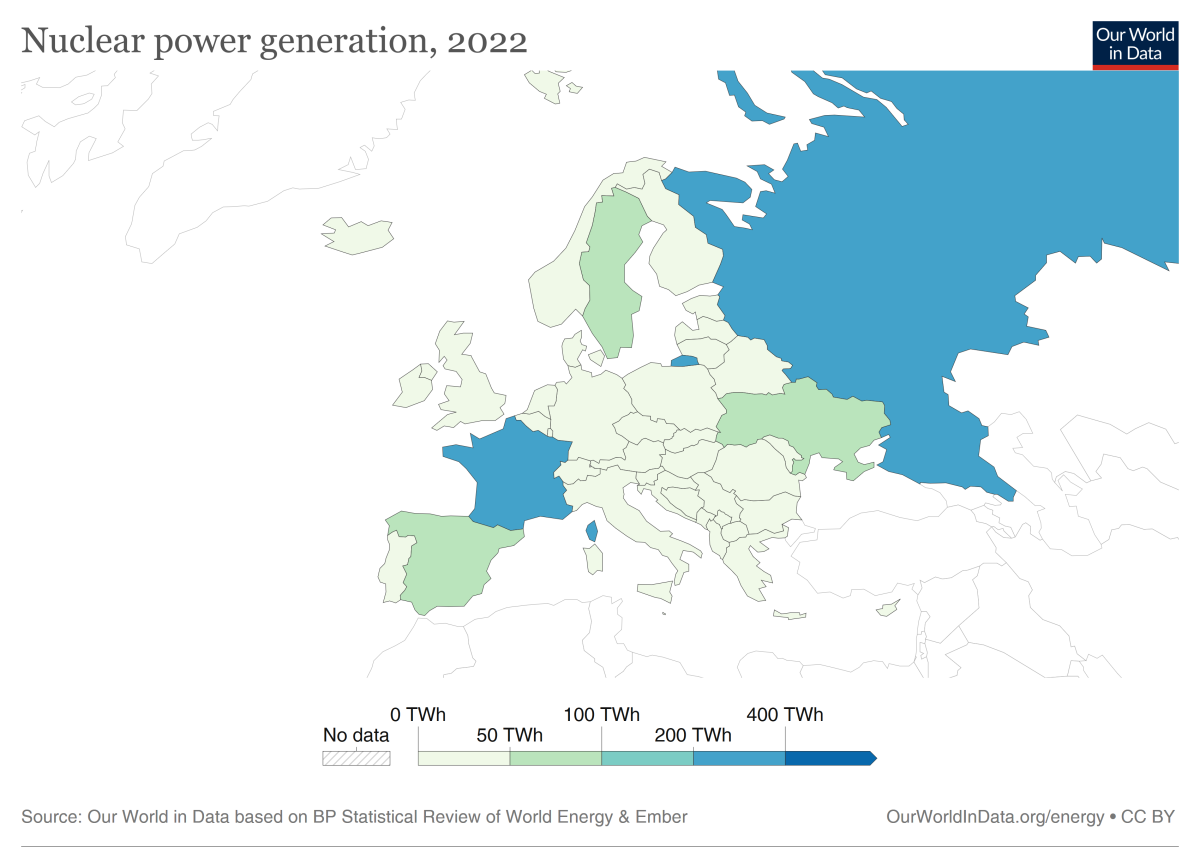
Fossil Fuels: Germany Leads Consumption with Gas as Key Driver
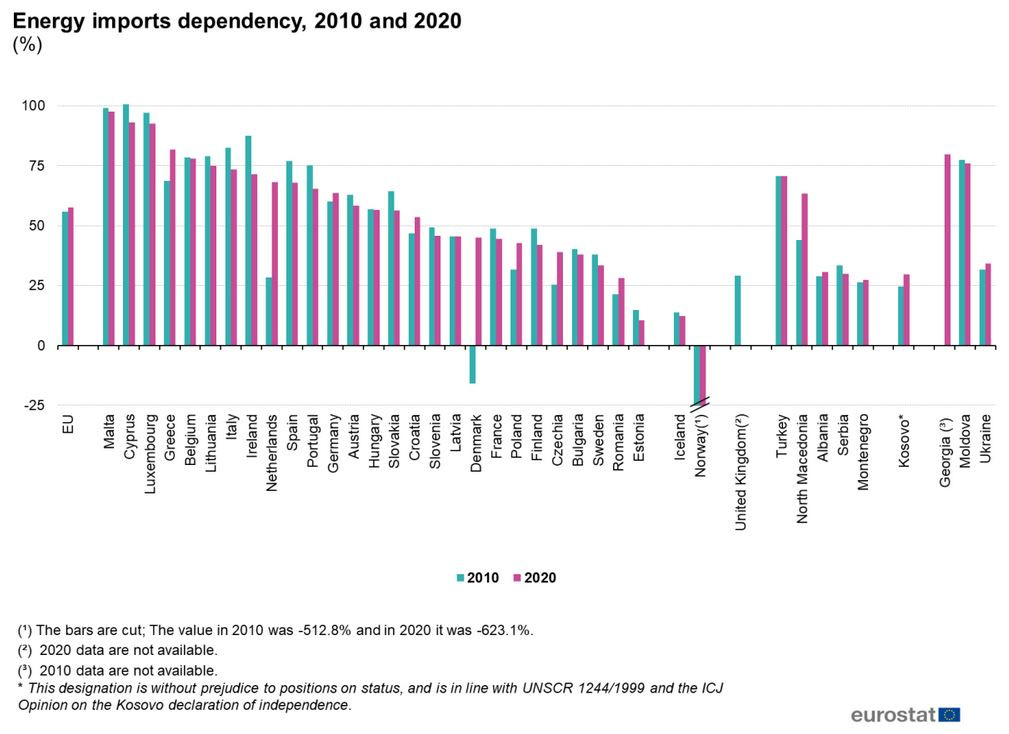
As of 2022, fossil fuels still cover over three quarters of Germany’s gross energy consumption – with oil providing about 35 percent, coal 20 percent and gas nearly 24 percent. However despite redeploying some of its already retired coal plants during the energy crisis, so far the country seems prepared to achieve its 2038 deadline to complete the phase-out of coal – or perhaps even faster, if eastern coal regions can be made to follow their western counterpart’s example and attempt an exit as early as 2030. However, to replace gas, coal in 2022 fed almost 8.5 percent more electricity into the grid than in the previous year.
While the use of oil (-24%) and coal (lignite -63%, hard coal -50%) has shrunk between 1990 and 2022, that of natural gas has increased markedly. In 2022, due to the supply cut from Russia, consumption was only 21 percent higher than 1990 – while in 2021 it was 41 percent higher. There currently is no exit date in Germany, although the 2045 climate neutrality target greatly limits the extent to which it can be used until then. The government currently plans to even expand gas-fired power production but aims to make new facilities ready to work on hydrogen as well, to supply industry processes and other sectors that are difficult to decarbonise otherwise.
Regarding oil consumption, mainly for transport and heating, there are no phase-out plans and neither any concrete proposals to exit combustion engines. However, a mix of carbon pricing in transport and heating and subsidies for electric cars and renewable heating are supposed to deliver a gradual transition away from oil.
Germany’s energy import dependency, mainly consisting of fossil fuels, was higher than the EU average in 2020, with 63.7 percent of all energy consumed, compared to 57.5 percent on average for member states. The figure for France was 44.5 percent.
Since 1990 France’s consumption of coal and oil has decreased by 72 percent and 27 percent, respectively. Conversely, natural gas use increased by 44 percent. With nuclear and hydroelectric production declining in 2022, gas-fired power plants were also called upon at an unprecedented level (+34% in metropolitan France).
France in 2021 affirmed that it would end all funding for oil projects by 2025 and gas projects by 2035. According to all the transition scenarios studied, fossil fuel investments will have to be halved before 2030, and disappear almost entirely by 2040, the I4CE think tank underlines.
Source: Clean Energy Wire









